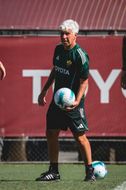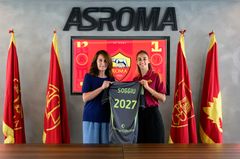
Our columnist reflects on the qualities that made Argentine striker Abel Balbo such a formidable goalscorer for the team during his first, five-year stay at the club...
After the 1996 clash between Roma and Sampdoria, in which Abel Eduardo Balbo scored a hat-trick, Carlo Mazzone told post-match interviewers that the player was like an “insurance policy”.
The striker was someone the coach could count on as he strived to rebuild Roma, a side laying the foundations for a return to the top of Italian football.
Balbo was an extremely effective and practical striker. Even today, when you look at some of his displays for the Giallorossi, you get the feeling that he almost had control of all those scrappy situations that would arise in the penalty box: the ball hitting the post and coming back into play, a parry from a goalkeeper or a deflection off a defender.
An eye for goal that comes from belief
Balbo scored 87 goals for Roma between 1993 and 1998, proving to be a worthy successor to the great No. 9s that had preceded him. He then returned to the club between 2000 and 2002 and formed part of the Scudetto-winning squad.
His goal-scoring talent came from his ability to read situations before his opponents, sensing how play would develop or when a defender would fatally hesitate. Abel’s knack for goal-scoring was described by journalists in Italy as a “fiuto del gol” - he could sniff out a goal.
He was able to sniff out goals because he never stopped believing. That’s why so many of his goals, which may at first glance seem random or lucky, and by no means stylistically perfect, were actually underpinned by that great quality just a select few strikers possess: being in right place at the right time.
Goalmouth scrambles would often prove a happy hunting ground. Balbo would try his luck at the far post, pulling himself away from the crowd and moving goalwards with a curved run from the centre. This helped him lose his markers, leap into the air with greater momentum and pounce on favourable deflections.
That approach helped Balbo score his first goal for Roma, on 5 September 1993, in a 2-1 victory over Juventus at the Stadio Olimpico.
The goal comes from a corner where the Curva Sud and Tribuna Monte Mario link, as an in-swinging ball from Sinisa Mihajlovic catches out Angelo Peruzzi, allowing the ball to reach Balbo at the far post. The striker has managed to escape his marker Massimo Carrera and arrives at full throttle to bundle the ball home.
In that period, Balbo was one of the Serie A’s best when it came to playing on the shoulder of the defender, before darting towards the near post or into the heart of the penalty box. By the time the defender had caught up with the Argentine it was often too late, as was the case in the classic 3-0 derby win over Lazio on 27 November 1994.
Balbo loses an aerial duel in midfield and the ball reaches Massimiliano Cappioli, who immediately sends it long towards Daniel Fonseca.
When the Uruguyan’s cross comes in from the right, slightly deflected by Cristiano Bergodi, you expect the No. 9 to meet it at the near post but Balbo emerges out of nowhere, in the heart of the Lazio box.
José Chamot, Paolo Negro and Aron Winter are too fixated on the ball and lose sight of Balbo, who is able to head the cross home.
This was one of nine headed goals Balbo scored for Roma.
Non just an opportunist
In his six seasons at Roma – five as a regular starter – Balbo showed a wide repertoire of capabilities, a reminder that he was not simply an opportunist. In addition to his exploits as a fox in the box, there were some spectacular efforts such as his five goals from free-kicks and four strikes from outside the penalty box.
One example was the vicious right-foot drive against Parma on 9 April 1994, in a game that Roma won 2-0. It’s one of those shots that stays hit and is still rising as it flies into the top corner.
Balbo finds himself in space and is able to bring the ball forward, lift his head up, and pick his spot. Here is the result.
The Argentine was not the quickest, but his ball control and physical strength helped him score splendid goals like the one he netted against Vincenza on 2 February 1997, when he scored both goals in a 2-0 win.
The second of the two was even applauded by opposition coach Francesco Guidolin, as the press reported the following day.
Balbo brings the ball forward on the counter-attack, finding himself up against two defenders as he takes the ball into the opposition half.
He nutmegs Luigi Sartor as he tries to intervene, which takes the ball wider.
As he reaches the box, Balbo produces another feint to beat the same defender, switches the ball to his right foot and curls a pin-point finish past Luca Mondini in the Vicenza goal.
Away from the box
The Roma front man established himself at time of significant change in Serie A, both in terms of tactics, training methods and regulatory changes, such as the back pass and offside rules as well as the brandishing of red cards for fouls from behind.
Balbo was able to adapt to the changes without distorting his primary qualities. In addition to being a great finisher, he was able to hold the ball up and help the team move up the field, earning valuable free-kicks or showing for the ball.
He was often seen drifting from the opposing area, to lose his direct marker (many teams defended man-to-man in the 1990s) as well as to open up passing lanes and space for midfielders and other forwards.
Here we see Balbo offering precious support to Francesco Moriero, playing a one-two that allows him to set up Cappioli’s goal in the famous derby win of 27 November 1994.
Relationship with Fonseca
A positive turning point in Balbo’s spell at Roma came with the arrival of Daniel Fonseca in the summer of 1994. You only need to compare his level of performance in his first season with the Giallorossi (1993-94), when he scored 12 goals, to that in the subsequent campaign, when he netted 22 league goals.
“It will only take a week for us to understand each other,” the Uruguayan told La Roma magazine upon his arrival.
The duo combined perfectly and ended their first season together with 32 goals combined: 22 for the Argentine and 10 for the Uruguayan. Balbo mainly occupied the central area and, thanks to his movement, he created space and provided inspiration for attacks.
Fonseca, meanwhile, rather than being a reference point would try to slip between gaps, worrying the opposition defence with his runs in behind and his ability to beat defenders in one-on-ones.
There was absolute harmony between the pair, with certain movements appearing natural. Below there are two goals that are almost carbon copies of one another.
Both scored by Balbo, one against Padova (2-0, 5 November 1995) and another against Piacenza (3-1, 7 September 1996), they are the fruit of crosses from the right. Fonseca feints to shoot and allows the ball to run to Balbo, who supplies a clinical finish.
There he is once again, in the middle of the box, with his red under-shorts: Abel Balbo, a striker who remains dear to Roma supporters.
Abel Balbo represented AS Roma between 1993-1998 and 2000-2002.
In total he scored 87 goals for the club, which at the time put him fourth on the club's all-time goalscoring charts (he now sits eighth).
He was a part of the Scudetto-winning side of 2001, and was a member of the Argentina squad that finished runners-up at the 1990 World Cup in Italy.

 Tickets
Tickets
 Shop
Shop




































